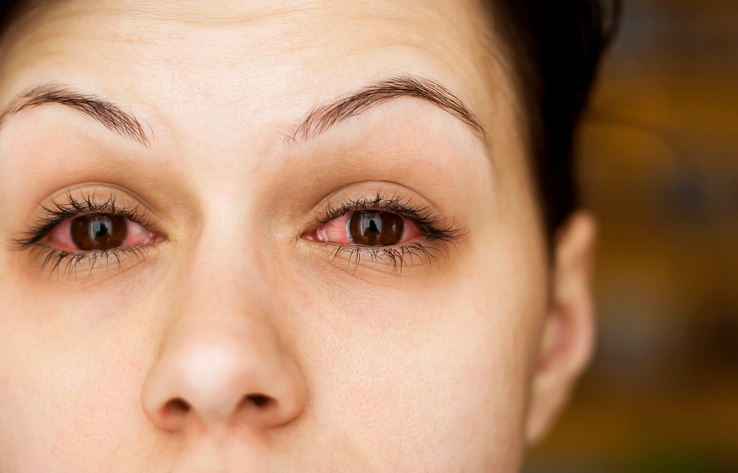What is conjunctivitis?
Conjunctivitis is an inflammation of the conjunctiva, the thin, transparent layer covering the surface of the inner eyelid and a portion of the front of the eye. It has several causes and affects people of all ages, and is especially common in school-age children.
Most cases of conjunctivitis are not serious and will pass on their own. However, if you or your child has had pinkeye for several days and it is not clearing, please schedule an appointment to have our Optometrist look into your symptoms.
What causes conjunctivitis?
The three main types of conjunctivitis are infectious, allergic and chemical. The infectious form is usually caused by a contagious virus or bacteria. Your body’s allergies to pollen, cosmetics, animals, or fabrics often bring on allergic conjunctivitis. Irritants like air pollution, noxious fumes and chlorine in swimming pools may produce the chemical form.
Signs and symptoms
Common signs and symptoms of conjunctivitis are:
• Red eyes
• Inflamed inner lids
• Watery eyes
• Blurred vision
• A sandy or scratchy feeling in the eyes.
With the infectious form, there may be a puss-like or watery discharge. Allergic conjunctivitis is often associated with stringy white mucous and itchiness.
Diagnoses
While the primary symptoms of conjunctivitis (the redness of the eye’s conjunctiva) are the same across all variations of conjunctivitis, variations of the condition have some unique symptoms. To diagnose bacterial or viral conjunctivitis, a swab of your eye secretions may be taken and sent to the lab for processing.
Our Optometrists see hundreds of patients each year for this eye condition. We are adept at quickly diagnosing it, determining its cause, and treating its frustrating symptoms.
Types of Conjunctivitis
While all forms of conjunctivitis are referred to as “pink eye” by most people, there are actually three variations of it.
- Viral – This version typically accompanies a cold. The discharge from viral conjunctivitis is generally “thin” and watery.
- Bacterial – This version typically comes with an ear infection. The discharge from bacterial conjunctivitis is thick; when sleeping, this type of conjunctivitis can cause a “crust” to form over the eye.
- Allergic – People with seasonal allergies tend to experience this version of conjunctivitis the most. Watery, scratchy eyes are the main symptom of this version of the disease.
What measure can be taken to prevent spreading this condition?
To avoid giving infectious conjunctivitis to others, keep your hands away from your eyes; thoroughly wash your hands frequently; do not share pillows, towels, washcloths, cosmetics or eye drops with others and seek treatment promptly. if you or a family member has conjunctivitis we recommend staying home from work/school until your case is diagnosed. Small children, who may forget these precautions, should be kept away from school, daycare, camp and the swimming pool until the condition is resolved.
Will it harm my eyes?
Certain forms of conjunctivitis can develop into a more serious condition that may harm your eyes and affect your vision. Therefore, it’s important to have your condition diagnosed and properly and quickly treated.
Treatment
Conjunctivitis caused by bacteria may be treated with antibiotic eye drops and/or antibiotic ointment. Other infectious forms, caused by viruses, can’t be treated with antibiotics and in most cases are fought off by your body’s own immune system. Treatment for a viral infection is primarily supportive, in the form of artificial tears, cold compresses and possibly steroid eye drops. It is essential to see your optometrist who can diagnose the underlying cause of the infectious conjunctivitis and treat accordingly.
How is allergic conjunctivitis treated?
Remedies to relieve eye symptoms of seasonal allergies can involve oral over-the-counter antihistamine medications taken during your particular allergy season. For those who suffer from severe seasonal allergies, allergy shots may be the treatment of choice. This is usually preceded by tests performed by an allergist to determine exactly what substances you are allergic to.
Further comfort can be achieved by placing a clean face cloth soaked in ice-cold water over closed eyes. Over-the-counter artificial teardrops and antihistamine eye drops can also help reduce red, itchy and watery eye. Prescription eye drops should be considered for more severe allergy symptoms.
Despite the different remedies that exist to deal with seasonal allergies, there is no cure. It is not recommended to diagnose and treat your symptoms yourself. Consult your optometrist to recommend the best therapy to provide relief from seasonal allergies.
How is chemical conjunctivitis treated?
The ideal treatment for chemical conjunctivitis is to remove the cause of the irritation. For instance, if chlorinated water irritates your eyes, wear swimming goggles. In cases where these measures won’t work, other types of prescription and over-the-counter eye drops are available to help relieve the discomfort. Consult your optometrist to recommend the best therapy..
Source:
“Pink Eye (Conjunctivitis)” Ontario Association of Optometrists, Retrieved 13 June 2019. <https://www.optom.on.ca/OAO/Patients/Library/Pink_eye_conjuctivitis_.aspx>

